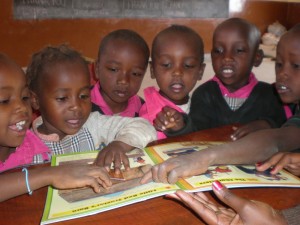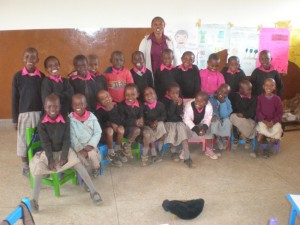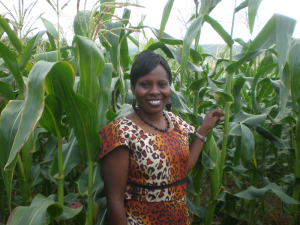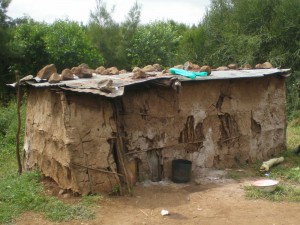In this newsletter we encounter vicious monkeys, baggy jumpers and grandma’s building skills.
We wake up late, body clocks on UK time to the sound of children singing at the Obaya School. This is something new. It’s 8am sharp and assembly has begun, outside for now, until the hall/dining room is finished. But why is there a group of miserable looking children leaning against a wall? This wall of shame is one of a number of initiatives the staff have introduced to get the school running efficiently. Time keeping is a dirty word for the Maasai partly because most have no watches or clocks. Time telling is by the position of the sun. Late arrivals to school are punished by missing the singing that heralds the new day. It’s working – lateness is much improved and we hear many arriving as early as 7am. School organisation has transformed since our last visit. We have duty staff, a brass school bell, time-tables on display and staff meetings. We are relieved and delighted – what a team!
The buildings are due for completion at the end of August – just a few drains are needed and the playground is still dangerously rocky. When the JCB breaks trying to dig up the rocks, a lone man painstakingly chips away at them with a hammer and pick axe – another punishment maybe? In fact he is over the moon to have a job paying £4 per day.
School website
The school is one of the few schools in Kenya to be found on the web. You can check it out here
Everyone is working well together and the school seems to have found its feet. The children are confident and happy as a group but still quite shy as individuals. The teachers delve excitedly into our latest box of car boot teaching equipment and we have to drag them away from lego brick creations for the much duller business of a staff meeting.
We meet two happy mothers – budding entrepreneurs who will thrive as the school grows. Not only are their children being sponsored and educated but they are making a bit of money from the school. One supplies firewood for our eco stove in the school kitchen and the other sells milk for the children’s tea.
We invite all children with peep-toe shoes to be measured; 16 lucky ones get free, quality, second hand shoes donated from various UK supporters. Many more are needed, so if you have any children’s shoes, they will be greatly appreciated.
Agriculture lessons
We are rather proud of a fruitful new initiative. Until recently the Maasai have never stayed put so growing anything is a mystery to most. 10 women turn up to weekly classes. David Minisa, a Maasai farmer, teaches them about digging, compost, fencing, and how to avoid using chemical pesticides by using cows’ urine mixed with weeds. He gives them seeds suitable for the semi-arid climate.
A handful of Maasai already know how to grow crops. Silantoi, aged 13 sits on the flat top of an acacia tree. Why would she choose a thorny tree in the midday sun to do her homework? The answer lies in the field of almost ripe maize below – heaven for hungry monkeys. Left to it, troupes of them will run off with arms full of cobs. More cobs are stuffed in their mouths and under their armpits. Silantoi’s job, from dawn till dusk is to shoo them away but it’s dangerous work – they will readily attack a big dog, gouging it’s muzzle with their sharp nails. By the way, Silantoi recently started school at 12. She will finish primary school aged 20.
Secondary school
I’m sure the three sponsors of older girls at Maasai Plains School won’t mind sharing this. Their Head Teacher Catherine notices that when her girl pupils go to secondary boarding school they tend to get fat. She puts this down to a diet full of carbohydrate and no exercise. Her own primary pupils leave home at 6 am and walk an hour to school. All three, aged between 14 and 16 are very body-conscious and wear baggy jumpers all year round to avoid teasing and attention from the boys. They find any excuse to avoid PE lessons – shared with the boys and especially refuse to jump or wear shorts which will expose their thighs. The Maasai are particularly modest and of course many of the children are still at Primary School when they are 16 or 17 or even older.
A sponsored child’s family
Many Westerners ask us what Olepolos village is like. Well, there isn’t one. Olepolos is not a village, it’s an area of bush about ten miles by 10 miles. Homes are widely scattered and it takes about five minutes to walk from one settlement to the next. We visit the home of Tiwa, one of our sponsored 7-year-olds to meet his family.
The Maasai live with their extended family in a group of huts surrounded by a thorn hedge to keep livestock safe at night. This group is called a manyatta. Women will go to live with their new husband in his family manyatta. Some men have two, three, even four wives, each living in her own hut with her children but in the same manyatta. Children are considered a blessing – the more the merrier.
Women build the huts of sticks mixed with mud and cow dung. A couple of cooking pots, tin or plastic plates a mug or two and a kerosene lamp are often the only bought possessions. There are no windows and no chimney so it’s very smoky making eyes sting. If there are not enough twig made beds the children sleep on the mud floor often sharing the space with young goats. It’s not the easiest space to keep homework and school uniform clean.
Tiwa’s father works as a security guard in Nairobi. He works for a month then has 5 days off at home. After he has paid for his Nairobi accommodation and travel, he brings about £10 per week back to his family. He is one of the lucky few from the area to have a job.
With our complicated lifestyles full of choice, some Westerners might say Maasai daily life is very repetitive and rather boring. Men and young boys walk their livestock searching the barren bush for grass 6 or 7 days a week. Tiwa’s mother walks a couple of miles twice daily to collect water and firewood for cooking and washing. Girls help their mothers and look after younger siblings. Food is similar every day – usually ugali (maize meal pudding), with perhaps some beans or cabbage. A repetitive life it may be but the Maasai seem very happy with the predictability and hardships of their life.
We have 6 children aged between 4 and 8 who currently need sponsors. In January 2013, another 25 four year olds will start school, most needing sponsors. It costs £16 a month. If you can help one of these children, we would love to hear from you.
Thanks to all our wonderful supporters, whether by time or money. You really are helping to make a difference to this community.
Helen and Roger Pannell August 2012.








